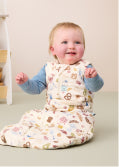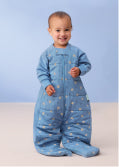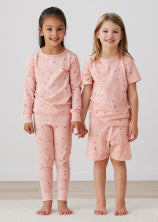Understanding Hip Dysplasia
Hip Dysplasia Guide
Developmental Dysplasia of the hip (DDH), or ‘hip dysplasia’ as it’s more commonly known, is when the ball of a baby’s hip doesn’t sit properly in the hip socket.
This can cause the hip to become unstable. Whilst common and treatable, it can cause problems later in life if left undiagnosed.
Hip instability is the most common musculoskeletal birth anomaly in the world and affects 1 in 6 newborns.*


How does DDH affect sleep?
A child wearing a brace will need to keep the brace on during sleep.
Follow their regular bedtime routine as much as possible
Use a specially designed swaddle or sleeping bag to fit comfortably over their brace, such as our Hip Harness Cocoon Swaddle Bag or Hip Harness Jersey Sleeping Bag
Put your child to sleep on their back in a safe-sleep space suitable for their age, size and developmental stage
To make them more comfortable, try rolling up the end of the sleeping bag and propping it under their legs/brace.
Diagnosis and treatment
In Australia, your healthcare professional should check your baby’s hips at birth, 1-4 weeks, 6-8 weeks and 12 months (or every MCHN appointment up to 12 months). If you notice symptoms that are going undetected at check-ups, please alert your GP or Maternal Child Health Nurse.
If your healthcare professional suspects DDH, your baby may be sent for further testing. This could be an x-ray, ultrasound, or you may be referred to a paediatric orthopaedic specialist for a second opinion.
For mild and moderate DDH, children generally wear a hip brace (orthosis) for three months, 23 hours of the day. For more severe DDH, babies wear braces for six months or longer. Babies with more severe DDH may require surgery.


What are the symptoms of DDH?
- One of your baby’s legs looks shorter
- Your baby’s legs are tight when you try to open them to change his nappy
- Your baby has uneven thigh or buttock creases
- Your child limps, avoids weight-bearing or walks on tippy-toes as she gets older
- Your baby holds their weight off to one side when sitting
- A popping or clicking sound or feel when hip joint is moved
Advice from a physio
“Being in the harness may affect physical development right now, but once they are out of the harness, they will have time to develop these skills.
Whilst in the harness, take time to focus on your child’s emotional wellbeing, engage with your child. Feeding may feel different, tummy time can be tricky, and cuddles may feel different, talk with your physiotherapist or other healthcare professionals to get more ideas of how to engage with your child and how to make them feel most comfortable.”
Jessica Shanahan, Physiotherapist











